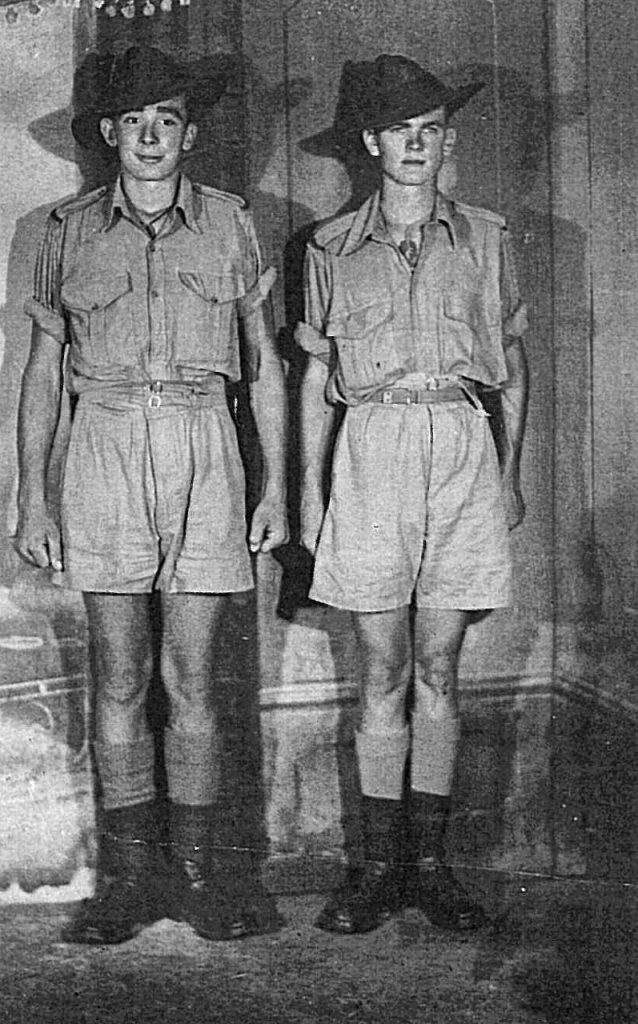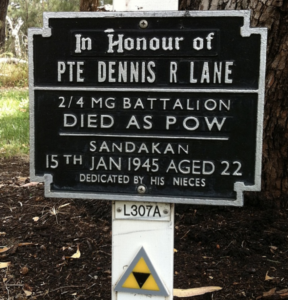The Soldier's Details

- Surname:
- Lane
- First Name:
- Dennis Richard
- Nick Name:
- Denny
- Rank:
- Private
- Regimental #:
- WX16439
- Company:
- ‘A’ Company, HQ
- Enlisted:
- 10.09.1941
- DOB:
- 23.10.1922
- Place of Birth:
- Shipton-on-Stowe, England
- Father's Name:
- George Lane
- Mothers's Name:
- Elizabeth Florence Lane (nee Jennings)
- Religion:
- Church of England
- Pre-war Occupation:
- Plasterer, Fixer and Greaser
- Memorial:
- Epitaph, Labuan Memorial, Panel 18, Age 22.
- Singapore:
- Selarang Camp and Barracks Changi
- Force:
- ‘E’ Force Borneo
- POW#:
- 4/6312 & 1783
- Cause of Death:
- Beri-Beri
- Place of Death:
- Sandakan No1 Camp
- Date of Death:
- 16.01.1945
General Description
Dennis Lane & Lew Lonsdale WX16727 ‘B’ Coy HQ, R.T.A. – both young men were reinforcements.
LANE, Private, DENNIS RICHARD, WX16439, A.I.F. 2/4 M.G. Bn., Australian Infantry. 16 January 1945. Age 24. Son of George and Elizabeth Lane, of Boulder, Western Australia. Panel 18.
Labuan Memorial, Malaysia.
Please read further about ‘E’ Force and Sandakan
Dennis was born in October1922 at Shipton-on-Stowe, England, the son of George and Elizabeth Lane. He had two sisters and a brother. He recorded his age incorrectly for the AIF – he was two years younger and aged 19 when he enlisted.
The family migrated with their daughter Isabella and two sons Anthony ‘Tony’ and Dennis. Their fourth child, daughter Eileen was born in WA at Carlisle.
Dennis attended school at Trafalgar, when the family moved to Boulder. We know George Lane worked at Lake View Mine. After leaving school he worked for a plastering works in Kalgoorlie.
He enlisted at Boulder in September 1941 and was posted to 2/4 Machine Gun Battalion as a Reinforcement, boarding ‘Aquitania’ 15 Jan 1942 and joining ‘A’ Company Headquarters initially under C.O. Major Saggers who was transferred to ‘E’ Coy SRB and Captain Thomas took over command just a few weeks prior to the fighting.
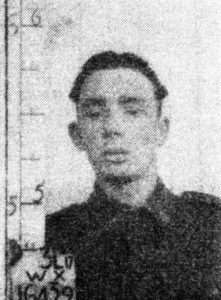
“Paybook photograph, taken on enlistment, of WX16439 Private Dennis Richard Lane, 2/4th Machine Gun Battalion, Australian Infantry. He was one of over 2000 Allied prisoners of war (POW) held in the Sandakan POW camp in north Borneo, having been transferred there from Singapore as a part of E Force. The 500 Australian and 500 British POW’s who made up E Force, left Changi on 28 March 1943, on board the S.S. DeKlerk arriving at Berhala Island (adjacent to Sandakan Harbour) on 15 April 1943. The POW’s were held there until 5 June, when they were taken by barge to Sandakan. The next day they were transferred to the 8 Mile Camp, which was about half a mile from the B Force compound. Private Lane, aged 24, died as a prisoner of the Japanese on 16 January 1945. He was the son of George and Elizabeth Lane, of Boulder, WA.”
His plaque at Kings Park Honour Avenue is placed alongside the plaque of his brother, Private Anthony Lane, who was killed in action in February 1942 on Timor. See below.
In recognition of Lane brothers.
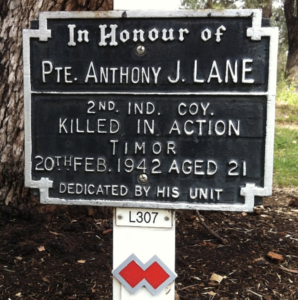
C
Above: Tony Lane from No. 7 Section, “C” Coy.
Older brother to Dennis is Private Anthony Lane known as ‘Tony’, service number WX12342 initially served with 28h Militia prior to transferring to AIF 2 May 1941 then joined 2nd Independent Company. He was killed in action at Timor on 20 February 1942 during first Japanese invasion of Timor.
Tony’s AIF records state he was executed by the Japanese on 20 Feb 1942. Understandably, his parents did not learn of his death until Feb 1946. (officials had four years of war to search through and trace men, confirm lost lives and inform families who had been waiting throughout the war.)
or go to Double Reds website
https://doublereds.org.au/history/men-of-the-22/
Written by 95-year-old Keith Hayes of 2nd Independent who survived the execution.
‘The Australian commandos, who were already in Timor based in the mountains outside Dili, had no idea the Japanese troops had arrived.
The morning after the Japanese landed, 20-year-old Mr Hayes was one of 15 men who drove down to Dili in a truck to pick up supplies.
Even though his mountain base was only 11 kilometres from Dili, a heavy fog had prevented a signaller from getting a message through.
Signaller Bryant Gannon died in vain as he flashed a Lucas lamp to alert the base.
The fifteen Australians fell into an ambush and were captured. ‘
(They were all executed the same day, except Keith Hayes who survived with his wounds.)
‘Surviving an execution
Mr Hayes was one of four men lined up for execution. Eleven other commandos were executed later that day.
But the bullet and a subsequent bayonet did not kill him.’
Below: Keith Hayes’ photo copied for this inclusion – Tony Lane was absent. We wish to acknowledge ABC and Keith Hayes.
Most of the men in this photograph were executed.
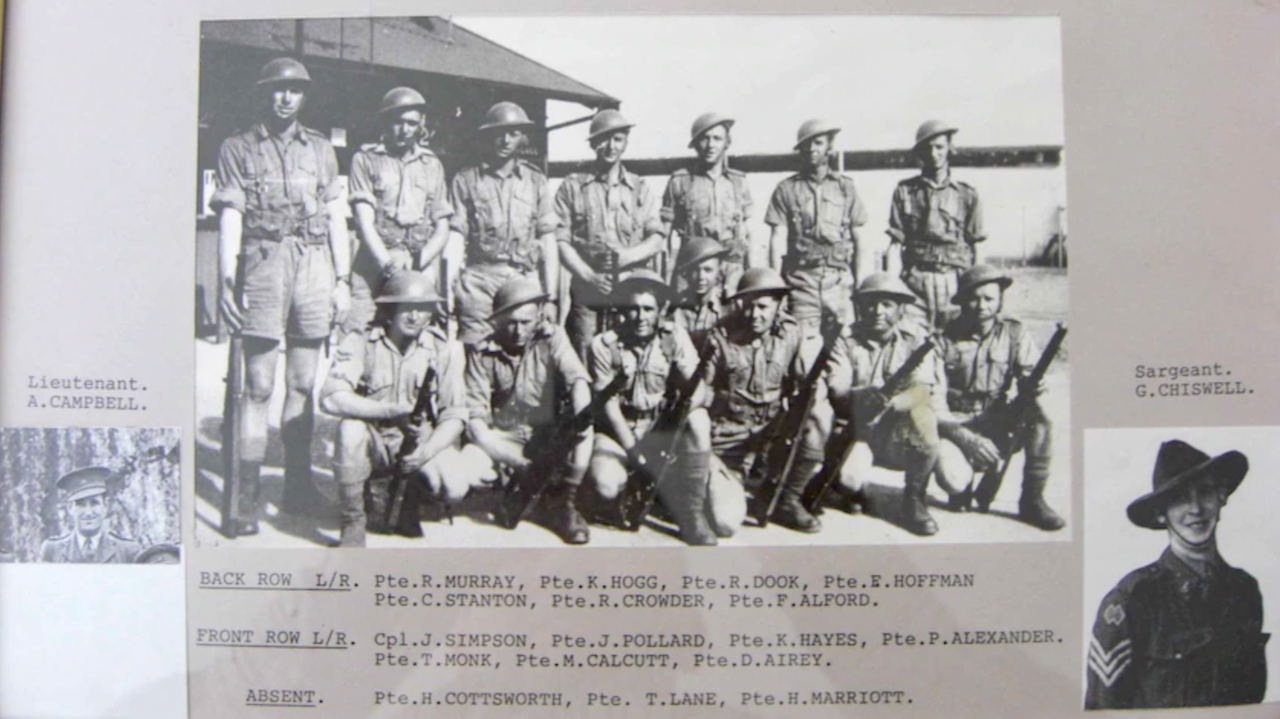
Tony Lane’s name is memorialised Panel 3, Darwin, Northern Territory Memorial.
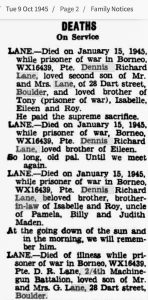
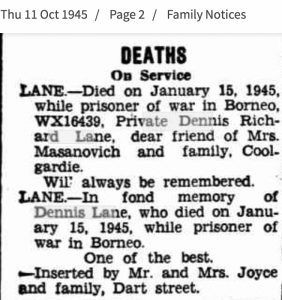
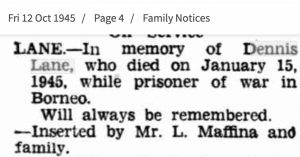
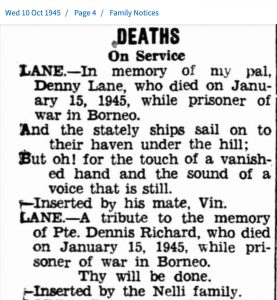
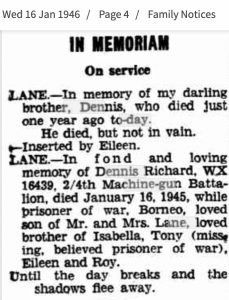
Above: It is January 1946 and the Lane family have not been yet been informed of Tony’s (Anthony John) 1942 death in Timor.
Below: Dennis Lane’s life is acknowledged forever at Labuan, amongst the men who died at Sandakan as well as the men who died when ‘Rakuyo’ Maru Sank 12 Sept 1944. (McCracken, Mutton and McMahon lost their lives in the South China Sea).
His 2/4th mates include George Lake, Lear, MaConachie, Moran, Nash and Newling.
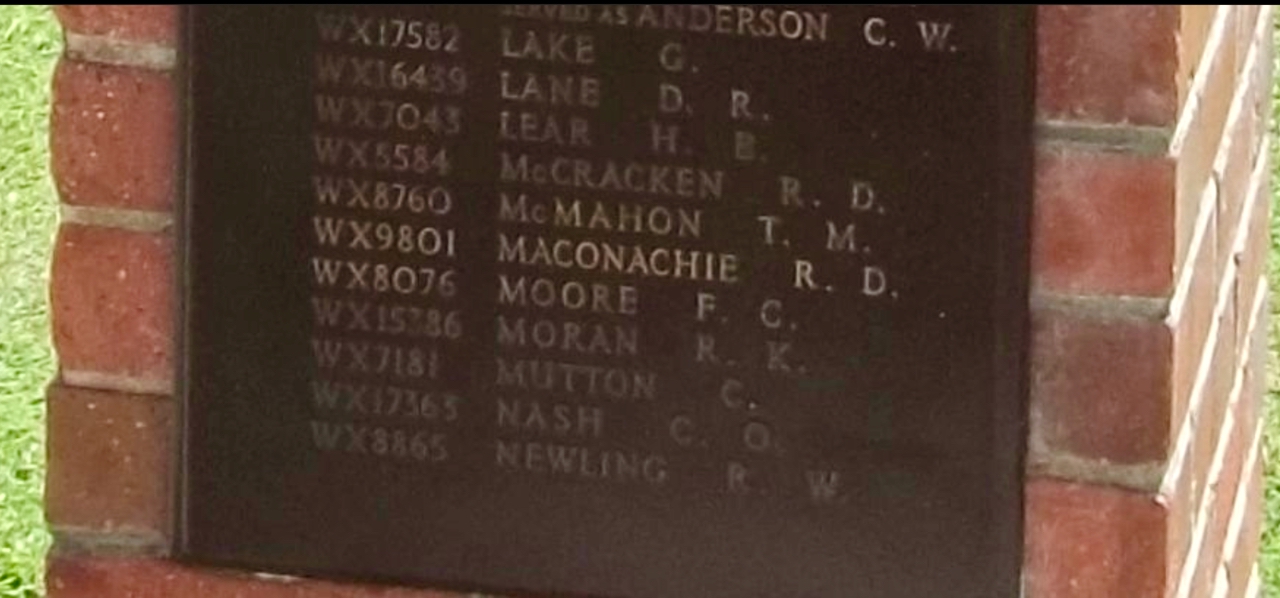
2nd Independent Company
Later became 2/2nd Commando Unit – the Double Diamonds
The 2nd Independent was raised in 1941 and trained at the Guerrilla Warfare Camp at Foster, near Wilsons Promontory, Victoria becoming 2nd Independent Company and later 2/2nd Commando Squadron. It was one of Australia’s 12 Commando Units. With 17 Officers and 256 other ranks, the 2/2nd was transported to Katherine, NT and stationed there until Japan attacked Pearl Harbour.
With the threat of Japan’s advancement, the 2nd Independents with 2/40th and a small artillery force formed ‘Sparrow Force‘ and sent to Timor, arriving Dilli 17 Dec 1941. Most of the 2nds moved to protect Dili airfield in east Timor, whilst other elements took up positions in the nearby mountains.
Those in the mountains, did not know of Japan’s invasion of Timor 20 February 1942, attacking both east and west Timor at the same time. The Australian and Dutch Forces were quickly overwhelmed by a larger number of enemy. The 2nd Independents hopelessly outnumbered, was unable to hold the airfield and forced to retreat to the mountains. They were joined by some 2/40th, and Dutch who managed to escaped capture. From here they waged a guerrilla campaign against the Japanese for nearly 12 months. This would not have been possible without the support and sacrifice of the local Timorese.
It was initially believed the 2nd Independents had been captured with 2/40th and listed as missing. Towards the end of April 1942, the unit was able to make contact with Darwin using a wireless transmitter nicknamed ‘Winnie the War Winner’. It had been put together by a member of the unit who had a background as an amateur radio operator. The RAN was then able to supply the guerrillas via the south-east coast enabling them to continue their campaign.
They inflicted casualties far in excess of their number – showing the usefulness of guerrilla forces against a numerically superior enemy. The tragedy was the Timorese suffered Japanese military attacks and shocking reprisal deaths.
Many members of the unit were rescued; reinforced and re-equipped in Australia going on to fight in New Guinea and New Britain campaigns as the 2/2nd Commando Unit.
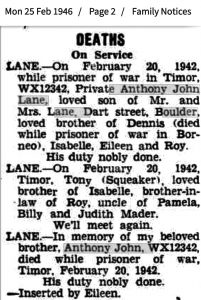
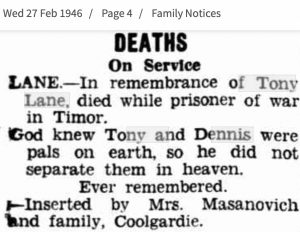
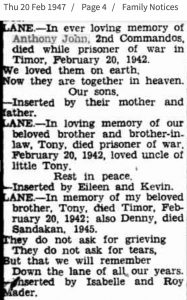
Below: It is 8 years later.
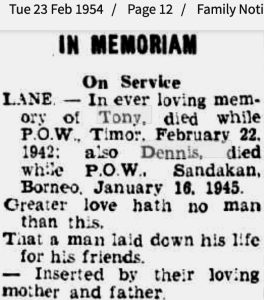
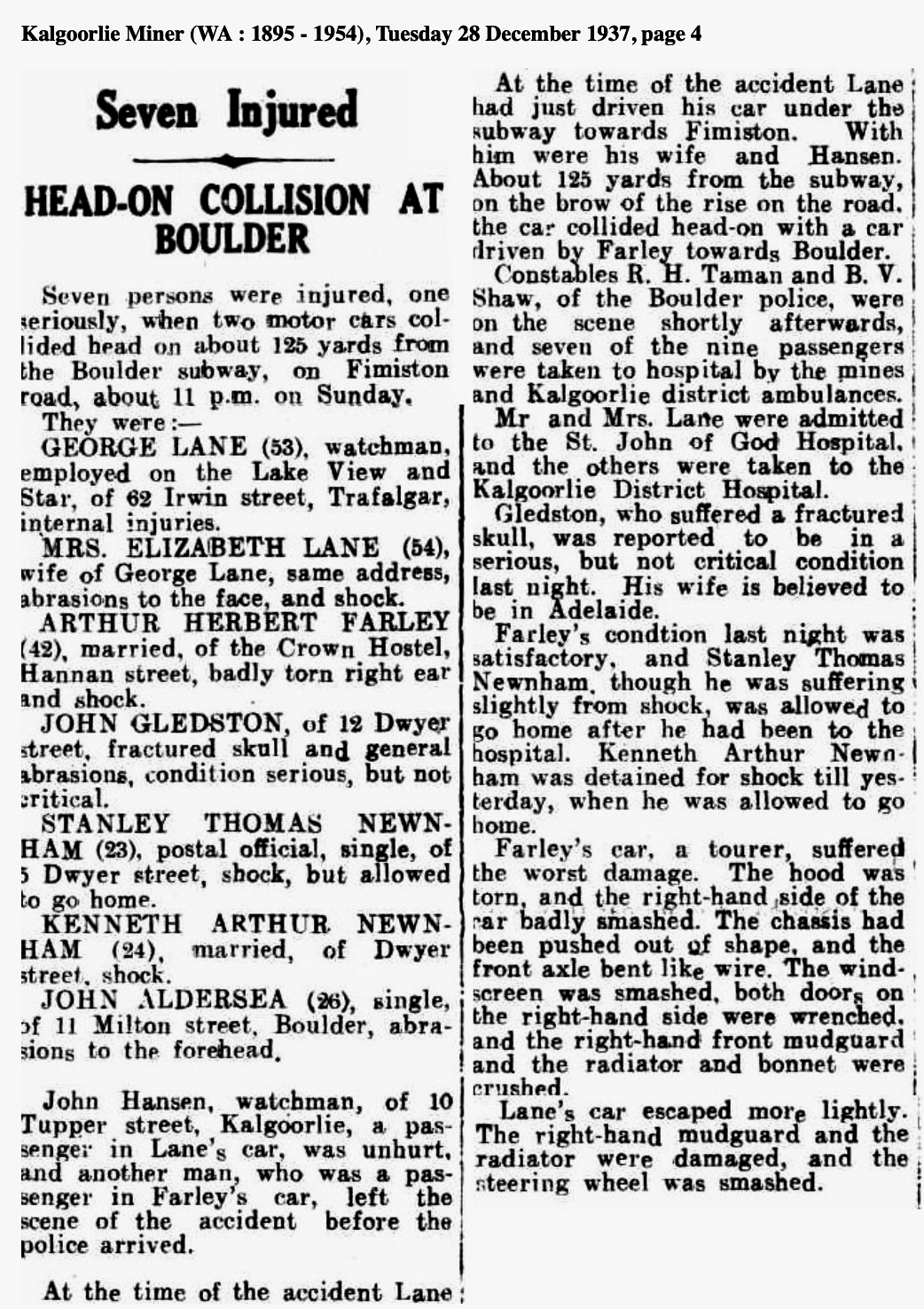
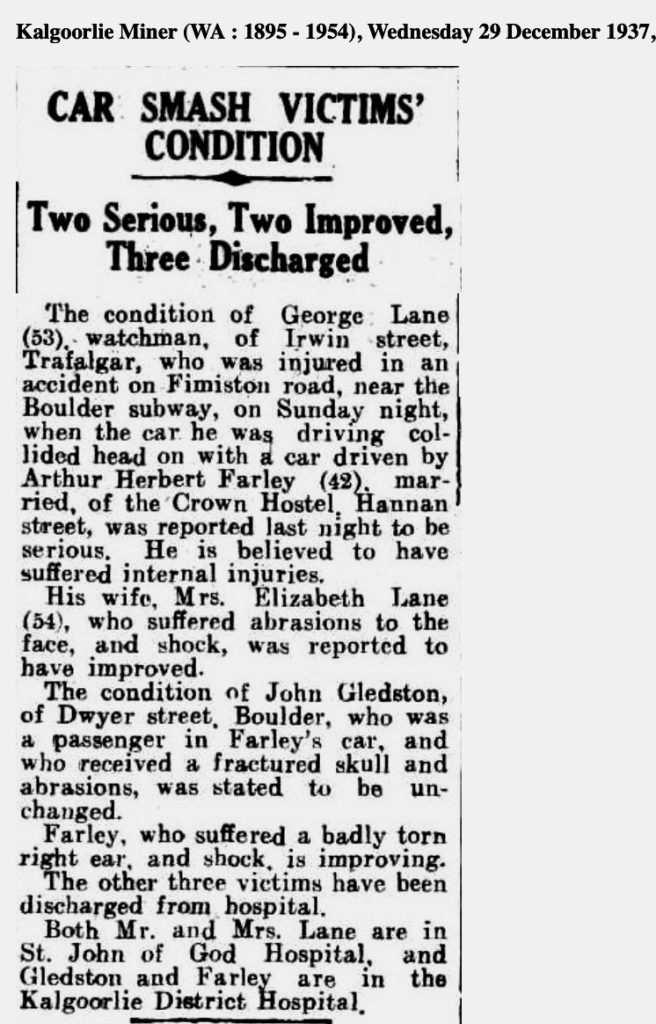
Camp Locations:
- Selarang Barracks Changi - Singapore
- Selarang Camp Changi - Singapore
- Sandakan - Borneo ***
- Lintang Officers Camp, Kuching - Sarawak

